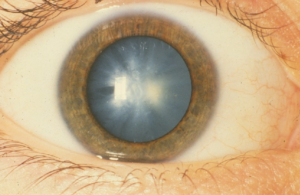Cataracts
A cataract is a clouding of the natural intraocular lens and can cause a decrease in vision. Cataracts often develop slowly and painlessly, so vision and lifestyle can be effected without a person realizing it.
Symptoms
Common complaints include blurry vision, difficulty reading in dim light, poor vision at night, glare and halos around lights, and occasionally double vision.

There is no medical treatment to prevent the development or progression of cataracts. Cataract surgery, which is the removal of the cloudy lens and implantation of a clear intraocular lens (IOL), is the only definitive treatment for cataracts
Cataract Surgery
The only way to remove a cataract is with surgery. Dr. Rothbaum will recommend removing a cataract when it keeps you from doing things you want or need to do. Cataract surgery is one of the most effective and most common procedure performed in all of medicine with 3 million Americans choosing to have cataract surgery each year. The overall success rate is 97 percent or higher when performed in appropriate settings. Cataract surgery will be done in an outpatient surgery center or hospital.
The most common type of cataract surgery in the United States utilizes ultrasound energy to break the cataract into particles small enough to aspirate through a hand piece. This technique is referred to as Phacoemulsification. Usually, Dr. Rothbaum will not need to stitch any incisions closed. These “self-sealing” incisions eventually will close by themselves over time. The goal in modern cataract surgery involves not only the removal of the cataract, but also the replacement of the cataract with an intraocular lens (IOL). The goal of all IOLs includes improved vision and limited dependency upon spectacles or contact lenses.
With phacoemulsification cataract surgery, an ultrasound instrument breaks up the center of the cloudy lens and suctions it out.
IOL Implants: Lens Replacement After Cataracts
An intraocular lens (or IOL) is a tiny, artificial lens for the eye. It replaces the eye’s natural lens removed during cataract surgery.
IOLs come in different focusing powers, just like prescription eyeglasses or contact lenses. Dr. Rothbaum and his staff will measure the length of your eye and the curve of your cornea. These measurements help to set your IOLs focusing power.
What are IOLs made of?
Most IOLs are made of silicone or acrylic. They are also coated with a special material to help protect your eyes from the sun’s harmful ultraviolet (UV) rays.
Types of IOLs
The most common type of lens used with cataract surgery is called a monofocal IOL. It has one focusing distance. It is set to focus for up close, medium range or distance vision. Most people have them set for clear distance vision, and wear eyeglasses for reading or close work.
These IOLs provide both distance and near focus at the same time. They are designed so that you can see at a distance and up close without the need for corrective lenses (prescription or over-the-counter).
For people with astigmatism, there is an IOL called a toric lens. Astigmatism is a refractive error caused by an uneven curve in your cornea or lens. The toric lens is designed to correct that refractive error.
As you plan for your cataract surgery, we will discuss with you your vision needs and expectations. We will explain these IOL options in more detail so that you may make an educated decision on which lens you would prefer implanted.

